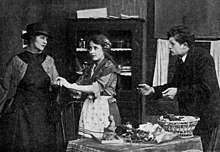Nina, the Flower Girl
Nina, the Flower Girl is a lost American 1917 silent drama film produced by D. W. Griffith through his Fine Arts Film Company and distributed by Triangle Film Corporation. The film starred Bessie Love, an up-and-coming ingenue actress.[1] It also marked the final acting role for Elmer Clifton, who was by then moving on to directing full-time.
| Nina, the Flower Girl | |
|---|---|
 Scene from the film | |
| Directed by | Lloyd Ingraham |
| Produced by | D. W. Griffith |
| Written by | Mary H. O'Connor |
| Starring | Bessie Love |
| Cinematography | Frank Urson |
Production company | |
| Distributed by | Triangle Film Corporation |
Release date |
|
Running time | 5 reels |
| Country | United States |
| Language | Silent (English intertitles) |
Plot
Nina (Love), who is blind, makes artificial flowers. Jimmie (Clifton), a hunchback newsboy, who is also an artist, is in love with her. Nina has been deceived into thinking that Jimmie is a prince who lives in a palace. When wealthy Fred Townsend (Hadley) and his mother offer to finance a surgery to restore Nina's vision, Jimmie misunderstands and thinks that the Townsends plan to hurt Nina. He unsuccessfully tries to protect her from them, before learning of their true intentions.
Nina has the surgery and her vision is restored, but Jimmie fears that she may not love him once she realized he is not a prince. He plans to attempt suicide by falling from a high place, but instead encounters a surgeon who performs a surgery to fix his hunchback. He and Nina are reunited and are in love.[2][3][4][5][6][7][8][9]
Cast
- Bessie Love as Nina, the flower girl
- Elmer Clifton as Jimmie, the newsboy
- Bert Hadley as Fred Townsend
- Loyola O'Connor as Mrs. Townsend, his mother
- Alfred Paget as Archie Dean
- Fred Warren as Dr. Fletcher
- Adele Clifton as Fifi Chandler
- Rhea Haines as Lotta, her chum
- Jennie Lee as Nina's grandmother
- Mrs. Higby as Mrs. Hicks[2]
Production
To prepare for her role as the blind girl, Love spent time at the Los Angeles Institute for the Blind.[3]
During filming, a 6-piece orchestra played music for the actors, and real champagne was used on camera.[5]
Release and reception
Upon its release, it was shown with a Keystone comedy.[10]
The film received mediocre to negative reviews.[11][12][13] In particular, its blatant sentimentality was poorly received.[14]
Bessie Love's performance was very well-reviewed,[3][6][11] called "an excellent bit of unaffected acting" by one reviewer.[15]
References
- Hanson, Patricia King, ed. (1988). The American Film Institute Catalog of Motion Pictures Produced in the United States: Feature Films 1911–1920. Berkeley, California: University of California Press. ISBN 978-0-520-06301-3.
- "Triangle Film Corp". The Moving Picture World. February 3, 1917. p. 745.
- "Oak Park Theatre". Forest Leaves. 11 (3). Forest Park, IL. January 19, 1917. p. 5.
- "At the Oak Park Theatre". Forest Leaves. 11 (3). Forest Park, IL. January 19, 1917. p. 14.
- "Living Pictures in New Bessie Love Play". Motography. Vol. 17 no. 2. January 13, 1917. p. 60.
- Graves, George W. (January 20, 1917). "Nina, the Flower Girl". Motography. Vol. 17 no. 3. pp. 150–1.
- Nash, Jay Robert; Connelly, Robert; Ross, Stanley Ralph (1988). Motion Picture Guide Silent Film 1910–1936. Cinebooks. p. 186. ISBN 978-0-933997-10-3.
- "Triangle Program". Motography. Vol. 17 no. 3. January 20, 1917. p. 160.
- Harrison, Louis Reeves (January 20, 1917). "Nina, the Flower Girl". The Moving Picture World. p. 358.
- "At Leading Picture Theaters". The Moving Picture World. February 3, 1917.
- Saxe, M. J. (February 10, 1917). "What the Picture Did for Me". Motography. Vol. 17 no. 6. p. 280.
- Milne, Peter (January 20, 1917). "Nina, the Flower Girl". Motion Picture News. Vol. 15 no. 3. p. 439.
- "Film Reviews". Variety. Vol. 45 no. 7. January 12, 1917. p. 24.
- Hutchinson, Tom (1984). Screen Goddesses. Exeter Books. p. 29. ISBN 978-0-671-07150-9.
- Todd, Stanley (October 1917). "The Rise of Bessie Love". Motion Picture Magazine. Vol. 14 no. 9. p. 37.
External links
| Wikimedia Commons has media related to Nina the Flower Girl. |
- Nina, the Flower Girl on IMDb
- Nina, the Flower Girl at AllMovie
- Nina, the Flower Girl at the TCM Movie Database
- Nina, the Flower Girl at the American Film Institute Catalog
- Nina, the Flower Girl at the British Film Institute
